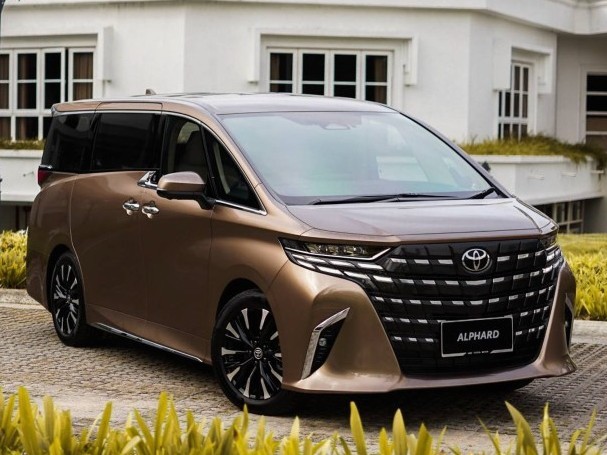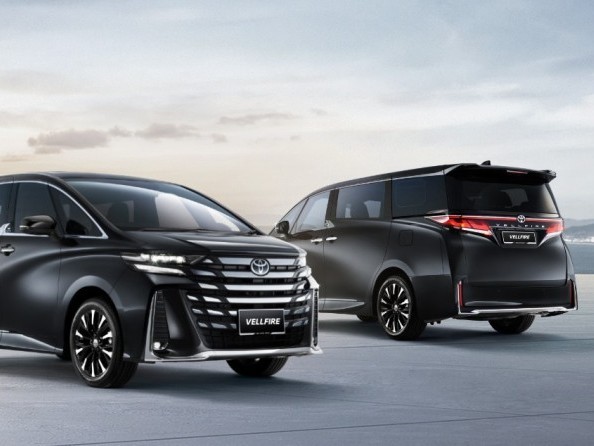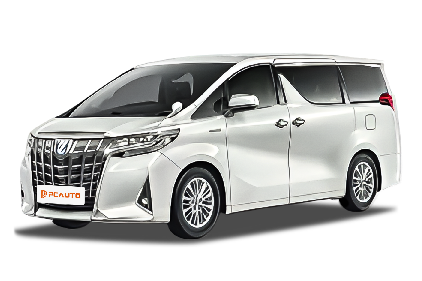Q
What is the fuel consumption of the Toyota Alphard 2024?
The fuel economy of the 2024 Toyota Alphard in the Malaysian market varies depending on the powertrain configuration. The combined fuel consumption of its 2.5-liter hybrid version is approximately 5.3-5.8 liters per 100 kilometers (according to the official WLTP test standard), while that of the 3.5-liter V6 gasoline version is around 9.5-10.5 liters per 100 kilometers. The actual fuel consumption may fluctuate slightly due to factors such as driving habits, road conditions, and the use of air - conditioning.
This luxury MPV adopts Toyota's latest TNGA platform technology. The hybrid system significantly improves fuel efficiency by optimizing the collaborative work of the electric motor and the engine, making it particularly suitable for the stop-and-go city traffic in Malaysia. It's worth noting that the hybrid models can further save fuel in the low - speed all - electric mode, while the V6 version is more suitable for users who often travel long distances on highways.
Malaysian consumers can refer to their own vehicle usage scenarios when making a choice. If the vehicle is mainly used in congested urban areas like Kuala Lumpur, the hybrid version can significantly reduce the cost of vehicle use. Moreover, Toyota has specifically tuned the compatibility with local fuel, so there's no need to worry about adaptability issues.
Special Disclaimer: This content is published by users and does not represent the views or position of PCauto.
Related Q&A
Q
Is the 2023 Alphard fuel efficient?
The 2023 Toyota Alphard delivers pretty average fuel economy. Its 2.5-liter hybrid setup returns around 6.5 to 7.2 liters per 100km in mixed Malaysian city driving, and can dip to 5.8-6.3 liters/100km on the highway. For a luxury seven-seat MPV, that's totally reasonable – and honestly, it's way more efficient than a comparable pure gasoline model. But here's the thing: hybrid efficiency really depends on how you drive and the roads you're on. Take it easy on the accelerator and brake predictively, and you'll squeeze even more km out of each liter.
Malaysian buyers should think hard about their actual needs. If you're often hauling a full load on long trips, the Alphard's spacious cabin and comfort might matter more than eking out every last drop of fuel. But if you're mostly stuck in stop-and-go city traffic, the hybrid system's electric-drive advantage at low speeds will shine.
Before you sign on the dotted line, check out the Malaysian Energy Efficiency Vehicle (EEV) certification data. More importantly, take it for a proper test drive to see how it actually performs in different road conditions. And don't forget, regular maintenance is key to keeping that fuel economy in check – stuff like changing the air filter on time and using the right viscosity oil.
Q
What is the fuel consumption of Toyota Alphard 2023?
The 2023 Toyota Alphard's fuel economy in the Malaysian market varies depending on the powertrain. The 2.5-liter hybrid variant delivers around 5.4 to 5.8 liters per 100 kilometers in combined driving, while the 3.5-liter V6 petrol version consumes approximately 9.5 to 10.5 liters per 100 kilometers. Actual figures may fluctuate slightly based on driving habits, road conditions, and vehicle load. For Malaysian buyers, the hybrid makes more sense for city commutes where stop-and-go traffic really eats into fuel efficiency, whereas the V6 suits those who frequently hit the highway for longer drives. It's worth noting that the hybrid system uses electric motor assistance to cut fuel use during idling and low-speed cruising – a big reason it stays efficient even in Southeast Asia's hot, tropical weather. To squeeze even better mileage, stick to regular maintenance like fresh air filters, keep tires properly inflated, and avoid aggressive acceleration or hard braking. As a luxury MPV, the Alphard strikes a solid balance between fuel economy and comfort, putting its efficiency right in the mainstream for its class.
Q
Is the 2023 Alphard good for families?
The 2023 Toyota Alphard stands out as a top-tier luxury MPV tailor-made for family life, and it's absolutely killing it in the Malaysian market. Let's face it, when families shop for an MPV, space and comfort are king – and the Alphard delivers big time on both fronts.
Inside, you've got a versatile three-row setup. The real star here is the second-row Ottoman seats; they're like first-class airplane seats, with multiple adjustments to dial in that perfect position, which is a total lifesaver on those long road trips to keep fatigue at bay. And unlike some MPVs where the third row is just an afterthought for kids, the Alphard's back row actually has enough room for adults too. That makes it a no-brainer for larger families or anyone who regularly hauls a crew around.
Keeping the little ones (and let's be honest, the big ones too) entertained is a breeze, thanks to the snazzy rear-seat entertainment screens and that crisp JBL sound system. Road trips just got a whole lot quieter – trust me, that's priceless.
Safety? Toyota's got you covered with their Safety Sense suite. We're talking pre-collision warning, lane keep assist, adaptive cruise control – all the good stuff that adds an extra layer of protection when you've got your most precious cargo on board.
Under the hood, the 2.5L hybrid powertrain you'll commonly find in Malaysia strikes a really nice balance. It's smooth as butter to drive and doesn't guzzle fuel, whether you're navigating city streets or cruising down the highway.
Add to that the Alphard's impressive cabin quietness and the high-quality materials used throughout the interior, and you've got a ride that feels properly premium. Yeah, it's not the cheapest option out there, but if your family values top-notch comfort and luxury, it's a solid investment.
If the Alphard's price tag makes you wince, there are other MPVs in the same class worth checking out, for sure. But when it comes to brand reputation and holding its value over time, the Alphard definitely has the edge.
Q
Is the 2023 Alphard a luxury vehicle?
The 2023 Toyota Alphard is truly a luxury MPV that's earned a solid reputation in Malaysia. Its popularity boils down to that premium spec sheet, super comfy ride, and a really well-finished interior. You're looking at leather seats, top-notch infotainment, zoned climate control, and a bunch of driver assists as standard – all the stuff luxury buyers crave for comfort and tech. It's a hit for family trips or when you need to impress clients.
In Malaysia's luxury MPV scene, the Alphard is a big player. That spacious cabin and how quiet it is on the move really cement its high-end vibe. And let's not forget the hybrid version – it's a greener pick, which lines up with what folks want these days in terms of fuel efficiency.
For Malaysian buyers, going for an Alphard isn't just about wanting luxury and practicality; it's also about trusting a brand that delivers. Toyota's after-sales network here is rock-solid, so you know you're covered long-term. If you're in the market for an MPV that blends luxury and usability, the 2023 Alphard is definitely one to check out seriously.
Q
Is Alphard better than Vellfire?
The Toyota Alphard and Vellfire are essentially two sides of the same coin—different styling takes on the same core vehicle. Mechanically, they're nearly identical, sharing the same performance, interior space, and key tech. The real differences lie in their exterior design and target audience. The Alphard goes for that luxury stable vibe with its big chrome grille up front, making it a solid pick for buyers after a more business-oriented look. The Vellfire, though, leans sportier with those split headlights and sharper lines, which tends to appeal more to younger families.
Here in Malaysia, both models pack the same 2.5L hybrid system (there's also the 3.5L V6 petrol option for those who want it), so you're looking at pretty much identical fuel economy and power delivery. Inside, the 2+2+3 seven-seat layout is standard across the board, and those second-row "captain chairs"? Total class leaders when it comes to comfort.
One thing Malaysian buyers really care about is after-sales support, and Toyota's got a strong edge there—their service network is widespread, and parts availability is generally good. If you're torn between the two, it really comes down to personal taste. If you're doing a lot of businessmeetings or client pickups, the Alphard's more understated elegance might be the way to go. But if it's mainly for family use and you want something with a bit more personality, the Vellfire should be right up your alley.
Oh, and a quick heads-up: both models are available here through parallel imports and official channels. Just make sure you check the warranty terms carefully before you buy—they can vary between the two.
Q
How much is Alphard 2023 in Malaysia?
The 2023 Toyota Alphard's pricing in Malaysia varies depending on the trim and specifications. The entry-level 2.5L model starts at around RM 400,000, while the top-spec 3.5L variant can push past RM 500,000. For the exact figures, you'll want to check with local dealerships and keep an eye out for any ongoing promotions they might have.
As a luxury MPV, the Alphard has always been a hit in Malaysia, loved by families and business folks alike for its spacious cabin, plush ride, and premium interior touches. It's got that perfect blend of comfort and upscale feel that keeps it in high demand here.
Of course, if you're shopping for a luxury people-carrier in Malaysia, the Alphard isn't your only option. The Honda Odyssey and Nissan Elgrand are also in the mix, each bringing their own unique strengths to the table. It really comes down to your personal needs and budget.
When you're ready to take the plunge, I'd recommend heading to an authorized dealership to get the full lowdown on specs, after-sales service, and financing options. That way, you can be sure you're getting the best possible deal and a smooth buying experience.
Q
Is 2024 Alphard comfortable?
The 2024 Toyota Alphard has become a highly-regarded premium MPV in the Malaysian market for its outstanding comfort. Its seats are made of high-quality leather and come with electric adjustment, heating, and ventilation functions. In particular, the second-row Ottoman airline seats support multi-angle adjustment, providing passengers with a first-class-like seating experience.
The vehicle is equipped with sound-insulation technology and an adaptive suspension system, which effectively filter out road vibrations and noise. Coupled with the spacious legroom and three-zone independent air-conditioning, it ensures comfort even on long-distance trips. It's worth noting that as Toyota's flagship MPV, the Alphard's comfort design takes into account the needs of tropical climates. For example, the rapid cooling system and anti-UV glass are especially practical for Malaysian users.
Among vehicles in the same class, the Alphard often serves as a vehicle for business receptions or family outings, thanks to its advantages in quietness and seat ergonomic design. However, it is recommended to take a test drive before purchasing, as the perception of comfort may vary slightly depending on individual body types and road conditions.
Q
What type of suspension does Alphard 2024 have?
The 2024 Toyota Alphard features a combination of front MacPherson independent suspension and rear multi - link independent suspension. This suspension configuration not only provides a comfortable riding experience but also ensures a certain level of handling stability, making it highly suitable for Malaysia's diverse urban roads and long - distance driving needs. The MacPherson suspension has a simple structure and takes up less space, which helps to improve the utilization of interior space. On the other hand, the multi - link rear suspension can better filter road vibrations, ensuring the comfort of rear - seat passengers.
In addition, the 2024 Alphard may also be equipped with an adaptive suspension system (such as AVS), which can automatically adjust the damping force according to road conditions and driving modes, further optimizing the driving and riding experience. For Malaysian consumers, this suspension design can not only handle the common road unevenness issues in the local area but also offer a more premium riding quality during family outings or business receptions.
It's worth noting that MPVs in the same class, such as the Honda Stepwgn or the Nissan Elgrand, also adopt a similar suspension layout. However, Toyota leans more towards comfort in the suspension tuning, which is one of the reasons why the Alphard is highly favored in the high - end MPV market in Malaysia.
Q
Does 2024 Alphard have GPS?
The 2024 Toyota Alphard in the Malaysian market is indeed equipped with a GPS navigation system. As one of the standard features of this luxury MPV model, the system is usually integrated into the touchscreen display on the center console. It supports real - time traffic updates and voice command operations, which makes it convenient for drivers to plan their routes.
It's worth noting that the Malaysian version of the Alphard may offer multimedia systems of different specifications according to specific configuration levels (such as the 2.5L or hybrid version). However, GPS navigation is commonly available in high - end models. Some models may also support Apple CarPlay and Android Auto smartphone connectivity to enhance navigation flexibility.
For Malaysian users, the local terrain is complex and urban roads are dense. The original GPS usually comes pre - installed with Southeast Asian map data. However, it is recommended to confirm with the dealer before purchasing whether it includes detailed maps of Malaysia and subsequent update services.
In addition, if owners have higher requirements for navigation accuracy, they can also install a third - party navigation module through the dealer or use the smartphone mapping function. But be aware that this may affect the original factory warranty terms.
For reference, MPVs in the same class, such as the Honda Stepwgn or the Nissan Elgrand, also offer similar navigation configurations. However, it is recommended to experience and compare the specific functional differences during a test drive.
Q
Is Alphard 2024 a 4WD?
The 2024 Toyota Alphard doesn't offer a four - wheel drive (4WD) version in the Malaysian market. All models in the lineup come with a front - wheel drive (FF) configuration, which is different from what some consumers might expect for a luxury MPV to be equipped with a four - wheel drive system. As a high - end model focusing on comfort and business reception, the Alphard's design emphasizes quietness, space utilization, and a smooth on - road driving experience. Therefore, the front - wheel drive layout can better meet these requirements while reducing mechanical complexity and fuel consumption.
If you need a four - wheel drive MPV, you can consider other models from the same class, such as the Mitsubishi Delica D:5 or the Nissan Elgrand (which offers four - wheel drive options in some markets). However, note that the visibility of these models in Malaysia is relatively low. A four - wheel drive system is usually suitable for users who often encounter slippery roads or engage in light off - road driving. But for most urban road conditions in Malaysia, the handling and stability of the front - wheel drive Alphard are more than enough. Its V6 engine and hybrid version also have sufficient power output for daily use.
It is recommended to weigh your options according to your actual needs before purchasing a car. If you prefer the Toyota brand and need four - wheel drive, you can pay attention to SUV models like the Land Cruiser or the Fortuner.
Latest Q&A
Q
Is a 2020 Hyundai Sonata a reliable car?
The 2020 Hyundai Sonata has proven to be quite reliable. It comes with either a smooth 2.5L naturally aspirated engine or a fuel-efficient 1.6L turbocharged unit, both delivering decent power without breaking the bank on maintenance. Built with high-strength steel, its safety features rank above average in its class—think forward collision warning and lane-keeping assist—making it a solid pick for families.
Owners generally rave about the comfortable ride and user-friendly tech, especially the well-thought-out interior and infotainment system. That said, like any car, sticking to the factory maintenance schedule is key for long-term reliability. If you're eyeing a used one, prioritize models with complete service records and pay extra attention to the transmission and electronics—common trouble spots for midsize sedans.
Q
What is the price of a 2020 Hyundai Sonata?
Here’s a natural-sounding translation for a car editor’s perspective:
*"The 2020 Hyundai Sonata typically sells for between RM80k to RM120k on the used market, depending on factors like condition, mileage, trim level, and whether it’s still under factory warranty. Back then, it offered two engine choices—a 2.0L naturally aspirated or a 1.6L turbo—paired with either a 6-speed or 8-speed automatic. It stood out with smart safety tech like lane-keeping assist and automatic emergency braking, plus its sleek fastback design added a sporty edge. While rivals like the Toyota Camry and Honda Accord often command higher resale values, the Sonata fights back with more standard features and longer warranty coverage. Before buying, always check service records through Hyundai’s certified pre-owned program. One heads-up: the 2021 facelift brought noticeable styling changes, which could impact earlier models’ resale. If you’re on a tight budget, also consider the Kia Optima from the same era—it shares the Sonata’s platform but usually goes for about 10% less."*
(Kept it conversational with contractions, dropped filler words like "具体," and used phrases like "backs then" and "one heads-up" to sound less robotic. Also streamlined tech specs for readability.)
Q
What is the safety rating of the Hyundai Sonata 2020?
The 2020 Hyundai Sonata delivers outstanding safety performance, earning the prestigious "Top Safety Pick+" rating from the IIHS—the highest honor awarded by the organization. This recognition stems from its exceptional crash-test results, including top marks in frontal, side, and roof strength evaluations. Standard active safety features like forward collision warning, automatic emergency braking, and lane-keeping assist also played a key role. Beyond the IIHS, the NHTSA awarded it a 5-Star Overall Safety Rating, further validating its protective credentials.
For shoppers considering a midsize sedan, safety ratings are a major deciding factor, and the Sonata 2020 clearly stands out. Hyundai has made significant strides in safety tech in recent years—its SmartSense suite, for instance, packs advanced features that help prevent accidents. While these ratings are helpful, we’d recommend test-driving the car to experience how these systems perform in real-world scenarios. That way, you can make a fully informed decision.
Q
Why is my 2020 Hyundai Sonata overheating?
**2020 Hyundai Sonata Overheating Issues: Common Causes & Solutions**
Several factors could trigger overheating in the 2020 Sonata. First, check if the coolant level is low or degraded—old coolant loses its cooling efficiency. Next, inspect the radiator fan or water pump. A faulty fan module or worn-out pump impeller can cripple circulation. Also, a stuck thermostat (closed position) may block coolant flow.
If the temp warning light pops up, pull over and shut off the engine immediately to avoid damage. Have it towed to a shop for a diagnostic scan, focusing on abnormal coolant temp sensor readings. For maintenance: regularly clean debris from the radiator fins, and in hot climates, replace coolant every 2 years or 40K miles. In stop-and-go traffic, crank the A/C to force the cooling fan to kick on.
Noticing frequent coolant loss? Check the head gasket seal—early Theta II engines had occasional leaks. Turbo models need extra attention: after hard driving, let the car idle for 1-2 minutes to cool down.
**Prevention beats repairs.** Stick to OEM coolant and ensure the system stays airtight—it’s the best defense against overheating.
Q
What is the electrical problem with the Hyundai Sonata 2020?
**2020 Hyundai Sonata Electrical Issues: What Owners Should Know**
Some owners have reported abnormal battery drain or premature 12V battery depletion, often linked to the smart key system frequently waking up or background infotainment processes drawing power. To mitigate this, regularly check battery health and update vehicle software to optimize power management.
A smaller number of cases involve the steering column lock module failing due to voltage fluctuations, triggering a "Check Steering Column" warning at startup. Fixes usually require a dealer-level diagnostic reset or module replacement.
Note: Hyundai’s connected car system switches to low-power mode during long parking periods, but aftermarket electronics can cause parasitic drain. Stick with OEM accessories to avoid issues.
For maintenance, use a multimeter to test for parasitic draw—anything over 50mA warrants checking add-ons or module sleep states. Simple checks like this help prevent sudden failures.
Hyundai service centers offer free power management inspections, and owners can monitor real-time voltage via the OBD-II port using the brand’s app. Staying proactive boosts electrical reliability.
View MoreRelated News

In Malaysia, which sliding door MPVs are available?
MichaelOct 30, 2025

How Much Is the Toyota Alphard? Luxury MPV Buying Guide & Cost Explained!
JohnApr 11, 2025

Difference between Alphard and Vellfire, Who is actually better?
RobertMar 4, 2025

It is possible that ZEEKR 009 will be introduced in the future, will this affect the sales volume of Toyota Alphard?
MichaelSep 25, 2024

Toyota unveils the new Corolla at the Auto Guangzhou in China. What changes will the future Corolla have?
AshleyNov 25, 2025
View More
















Pros
Cons